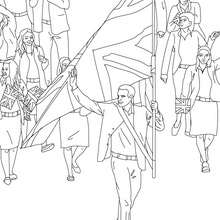PDF] Brain Tumor Segmentation of MRI Images Using Processed Image Driven U-Net Architecture
Por um escritor misterioso
Descrição
A fully automatic methodology to handle the task of segmentation of gliomas in pre-operative MRI scans is developed using a U-Net-based deep learning model that reached high-performance accuracy on the BraTS 2018 training, validation, as well as testing dataset. Brain tumor segmentation seeks to separate healthy tissue from tumorous regions. This is an essential step in diagnosis and treatment planning to maximize the likelihood of successful treatment. Magnetic resonance imaging (MRI) provides detailed information about brain tumor anatomy, making it an important tool for effective diagnosis which is requisite to replace the existing manual detection system where patients rely on the skills and expertise of a human. In order to solve this problem, a brain tumor segmentation & detection system is proposed where experiments are tested on the collected BraTS 2018 dataset. This dataset contains four different MRI modalities for each patient as T1, T2, T1Gd, and FLAIR, and as an outcome, a segmented image and ground truth of tumor segmentation, i.e., class label, is provided. A fully automatic methodology to handle the task of segmentation of gliomas in pre-operative MRI scans is developed using a U-Net-based deep learning model. The first step is to transform input image data, which is further processed through various techniques—subset division, narrow object region, category brain slicing, watershed algorithm, and feature scaling was done. All these steps are implied before entering data into the U-Net Deep learning model. The U-Net Deep learning model is used to perform pixel label segmentation on the segment tumor region. The algorithm reached high-performance accuracy on the BraTS 2018 training, validation, as well as testing dataset. The proposed model achieved a dice coefficient of 0.9815, 0.9844, 0.9804, and 0.9954 on the testing dataset for sets HGG-1, HGG-2, HGG-3, and LGG-1, respectively.
![PDF] Brain Tumor Segmentation of MRI Images Using Processed Image Driven U-Net Architecture](https://media.springernature.com/lw685/springer-static/image/art%3A10.1007%2Fs12652-022-03773-5/MediaObjects/12652_2022_3773_Fig2_HTML.png)
Brain tumor segmentation in multimodal MRI images using novel LSIS operator and deep learning
![PDF] Brain Tumor Segmentation of MRI Images Using Processed Image Driven U-Net Architecture](https://media.springernature.com/m685/springer-static/image/art%3A10.1186%2Fs12859-022-04794-9/MediaObjects/12859_2022_4794_Fig1_HTML.png)
A state-of-the-art technique to perform cloud-based semantic segmentation using deep learning 3D U-Net architecture, BMC Bioinformatics
![PDF] Brain Tumor Segmentation of MRI Images Using Processed Image Driven U-Net Architecture](https://html.scirp.org/file/1-9102840x6.png?20140121090614032)
Brain Tumor Segmentation of HGG and LGG MRI Images Using WFL-Based 3D U-Net
![PDF] Brain Tumor Segmentation of MRI Images Using Processed Image Driven U-Net Architecture](https://ijritcc.org/public/journals/1/submission_6951_6897_coverImage_en_US.png)
Automated Brain Tumor Detection from MRI Scans using Deep Convolutional Neural Networks
![PDF] Brain Tumor Segmentation of MRI Images Using Processed Image Driven U-Net Architecture](https://file.techscience.com/ueditor/files/iasc/TSP_IASC-32-1/TSP_IASC_21206/TSP_IASC_21206/Images/IASC_21206-fig-2.png/mobile_webp)
Optimized U-Net Segmentation and Hybrid Res-Net for Brain Tumor MRI Images Classification
![PDF] Brain Tumor Segmentation of MRI Images Using Processed Image Driven U-Net Architecture](https://content.iospress.com/media/xst/2020/28-4/xst-28-4-xst200650/xst-28-xst200650-g010.jpg)
DCU-Net: Multi-scale U-Net for brain tumor segmentation - IOS Press
![PDF] Brain Tumor Segmentation of MRI Images Using Processed Image Driven U-Net Architecture](https://media.springernature.com/m685/springer-static/image/art%3A10.1007%2Fs40747-022-00815-5/MediaObjects/40747_2022_815_Fig1_HTML.png)
Deep learning based brain tumor segmentation: a survey
![PDF] Brain Tumor Segmentation of MRI Images Using Processed Image Driven U-Net Architecture](https://0.academia-photos.com/attachment_thumbnails/63989069/mini_magick20200722-28755-1ebq4xj.png?1595405553)
PDF) UNet-VGG16 with transfer learning for MRI-based brain tumor segmentation
![PDF] Brain Tumor Segmentation of MRI Images Using Processed Image Driven U-Net Architecture](https://onlinelibrary.wiley.com/cms/asset/85e7cbd1-a542-4c37-9d7f-16c756eeef98/ima22571-fig-0008-m.jpg)
International Journal of Imaging Systems and Technology, IMA
![PDF] Brain Tumor Segmentation of MRI Images Using Processed Image Driven U-Net Architecture](https://journals.sagepub.com/cms/10.1177/20552076221074122/asset/images/large/10.1177_20552076221074122-fig1.jpeg)
Magnetic resonance image-based brain tumour segmentation methods: A systematic review - Jayendra M Bhalodiya, Sarah N Lim Choi Keung, Theodoros N Arvanitis, 2022
![PDF] Brain Tumor Segmentation of MRI Images Using Processed Image Driven U-Net Architecture](https://html.scirp.org/file/1-9102840x4.png?20140121090614032)
Brain Tumor Segmentation of HGG and LGG MRI Images Using WFL-Based 3D U-Net
de
por adulto (o preço varia de acordo com o tamanho do grupo)







